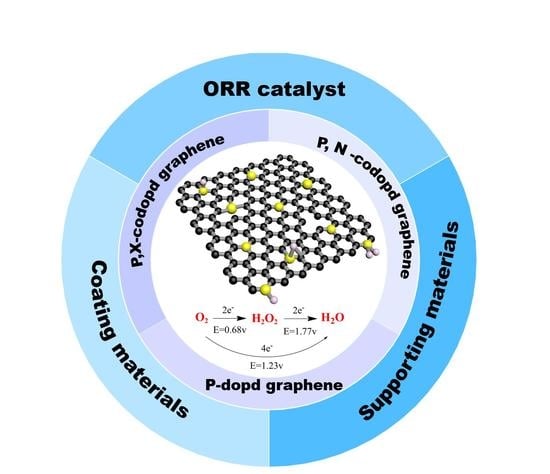Phosphorus-Doped Graphene Electrocatalysts for Oxygen Reduction Reaction
Abstract
:1. Introduction
2. The Synthesis of Phosphorus-Doped Graphene
2.1. Bottom-up Approaches
2.1.1. Chemical Vapor Deposition (CVD)
2.1.2. Organic Synthesis
2.2. Top-down Approaches
2.2.1. Graphite Oxide-Based Routine
2.2.2. Other Graphite Derivative-Based Routine
3. Phosphorus-Doped Graphene for Metal-Free ORR Electrocatalyst
3.1. Phosphorus-Doped Graphene
| The Material 1 | Synthesis Method | P-Content (at.%) 2 | Onset Potential | Half-Wave Potential | Electron Transfer Number | Ref. |
|---|---|---|---|---|---|---|
| P-graphene | Annealing the mixture of GO and 1-butyl-3-methlyimidazolium | 1.16% | −0.0261 V vs. SCE in 0.1 M KOH | ~−0.2 V vs. SCE | 3.9 | [55] |
| P-graphene | Annealing the mixture of GO and triphenylphosphine | 1.81% | 0.92 V vs. RHE in 0.1 M KOH | - | 3.0–3.8 | [54] |
| P-graphene | Supercritical fluid processing of GO and triphenylphosphine | 1.4–3.2% by EDX | 0.12 V vs. MMO in 0.1 M KOH | - | - | [78] |
| P-graphene | Immersed into the mixture of GO and NaH2PO4 | 2.6% | ~−0.3 V vs. Ag/AgCl in 0.1 M KOH | - | 3.9 | [79] |
| P, N-graphene | Pyrolysis of hexachlorocyclotriphosphazene (HCCP) and GO | 1.08% | −0.20 V vs. Ag/AgCl | - | 3.4–3.73 | [81] |
| P, N-graphene | Twice pyrolysis treatment of GO and phosphoric acid | - | 0.87 V vs. RHE in 0.1 M HClO4 | 0.64 V vs. RHE | - | [81] |
| P, N-graphene | Pyrolysis treatment of GO, polyaniline, and phytic acid | 1.72% | 1.01 V vs. RHE | ~0.84 V vs. RHE | 3.96 | [82] |
| P, N-graphene | Two-step solution process using phytic acid and GO | 0.6% | 0.89 V vs. RHE | 0.69 V vs. RHE | 3.9 | [83] |
| P, N-graphene | Pyrolysis treatment of GO and phytic acid | - | −0.11 V vs. Ag/AgCl | −0.34 V vs. Ag/AgCl | - | [84] |
| P, N-graphene | Hydrothermal and subsequent pyrolysis processes (GO and phytic acid) | 1.22% | 0.983 V vs. RHE | 0.865 V vs. RHE | 3.9–4.0 | [85] |
| P, N-graphene | Pyrolysis treatment of phytic acid | 0.67–0.71% | 1.0 V vs. RHE | 0.86 V vs. RHE | [86] | |
| P, N-graphene | Pyrolysis treatment of GO and diammonium hydrogen phosphate | 1.16% | ~−0.2 V vs. Ag/AgCl | ~−0.18 V vs. Ag/AgCl | 3.66 | [87] |
| P, N-graphene | Pyrolysis treatment of GO and diammonium phosphate | 2.32% | ~0.84 V vs. RHE | ~0.87 V vs. RHE | 3.99 | [88] |
| P,Fe-graphene | Sol-gel polymerization and pyrolysis process | ~2% | −0.139 V | - | 3.74–3.89 | [89] |
| P,Fe-graphene | Pyrolysis treatment of GO, phytic acid and FeCl2 | 0.84% | −0.05 V vs. Ag/AgCl in 0.5 M H2SO4 | - | 3.84 | [90] |
| P,Co-graphene | Pyrolysis treatment of GO, tetraphenylphosphonium bromide, Co(NO3)2 | 0.639% | 0.89 V vs. RHE | ~0.78 V vs. RHE | 3.87–3.96 | [91] |
| N, P, F-graphene | Pyrolysis of the mixture of GO, polyaniline, and ammonium hexafluorophosphate | 0.37% | ~0.83 V vs. RHE | ~0.72 V vs. RHE | 3.85 | [92] |
| P, S, N-graphene | Pyrolysis treatment of GO and acephate | 0.42% | −0.192 V vs. SCE | - | 2.99 | [93] |
| P, S, N-graphene | Pyrolysis treatment of GO and phosphoric acid | - | −0.052 V vs. SCE | 0.015 V vs. SCE | 3.67–3.97 | [94] |
| Fe, B, N, S, P-graphene | Pyrolysis treatment of GO and triphenylphosphine | 0.54% | 1.06 V vs. RHE | 0.9 V vs. RHE | 3.98 | [95] |
| P, B, N-graphene | Hydrothermal method (GO and boron phosphate) | - | −0.12 V vs. Ag/AgCl | - | 3.7 | [96] |
| P, B, N-graphene | Pyrolysis treatment of GO and phenylphosphine | 0.43% | 0.88 V vs. RHE | 0.80 V vs. RHE | 3.8 | [97] |
| P, Fe, N-graphene | Pyrolysis treatment of aphytic acid | 1.11% | ~0.95 V vs. RHE | 0.84 V vs. RHE | 3.2 | [98] |
| P, Ni, N-graphene | Pyrolysis treatment of GO and phytic acid | - | 0.88 V vs. RHE | - | 3.5 | [99] |
| P, S, N-graphene | Pyrolysis treatment of ammonium monohydrogenphosphate | 0.95% | 0.856 V vs. RHE | 0.74 V vs. RHE | 3.07 | [100] |
| P, S, N-graphene | Ball milling and pyrolysis treatment of phosphonitrilic chloride trimer | 1.16% | ~0.93 V vs. RHE | 0.88 V vs. RHE | - | [101] |
| MoPx @MnPy /P, N-graphene | Annealing the mixture of GO and the desired chemical | 4.12% | 0.965 V vs. RHE in 0.1 M KOH | 0.842 V vs. RHE | 3.95–3.97 | [102] |
| CoMn2O4/ P, N-graphene | Hydrothermal method and soaking hypophosphorous acid | 1.22% | −0.094 V vs. SCE in 0.1 M KOH | −0.2 V vs. SCE | 3.64–3.70 | [103] |
| Co/P, N-graphene | A hydrothermal method with the subsequent pyrolysis procedure | 0.83% using elemental analysis | 0.04 V vs. SCE | 0.18 V vs. SCE | ~4 | [104] |
| Co2P /Co, P, N-graphene | Supramolecular gel-assisted strategy and annealing method | 2.86% | 0.90 V vs. RHE | 0.81 V vs. RHE | 3.96 | [105] |
| Co3(PO4)2/P, N-graphene | Hydrothermal and annealing the mixture of desired chemical and phytic acid | - | 0.95 V vs. RHE in 0.1 M KOH | 0.81 V vs. RHE | 3.7–3.84 | [106] |
| Cu3P@ P, N-graphene | Annealing the mixture of desired chemical and 1-hydroxyethylidene1,1-diphosphonic acid | - | - | 0.78 V vs. RHE | 3.96–4.0 | [107] |
| Co@N, P, S -graphene | Thermal treatment of the mixture of desired chemical and kelp | - | 0.90 V vs. RHE | 0.74 V vs RHE | 4.0 | [108] |
| FeCo@P, N-graphene/N-CNTs | Thermal treatment of the mixture of desired chemical and polystyrene spheres | 2.77% | 0.95 V vs. RHE | - | 3.67–3.82 | [109] |
| FeP@P-graphene | Annealing of the mixture of hemin diammonium phosphate and melamine | 1.1% | 0.95 V vs. RHE in 0.1 M KOH | 0.81 V vs. RHE | 3.8 | [110] |
3.2. P, N Codoped Graphene
3.3. Phosphorus, X Codoped Graphene
4. Phosphorus-Doped Graphene Composite for ORR
4.1. P-Graphene as Catalyst Support Material for ORR
4.2. P-Graphene as a Coating Material for ORR
5. Perspectives
6. Conclusions
Author Contributions
Funding
Data Availability Statement
Conflicts of Interest
References
- Mu, Y.; Wang, T.; Zhang, J.; Meng, C.; Zhang, Y.; Kou, Z. Single-atom catalysts: Advances and challenges in metal-support interactions for enhanced electrocatalysis. Electrochem. Energy Rev. 2022, 5, 145–186. [Google Scholar] [CrossRef]
- Ren, X.F.; Liu, B.H.; Liang, X.Y.; Wang, Y.R.; Lv, Q.Y.; Liu, A.M. Review-current progress of non-precious metal for ORR based electrocatalysts used for fuel cells. J. Electrochem. Soc. 2021, 168, 044521. [Google Scholar] [CrossRef]
- Zhao, Z.H.; Li, M.T.; Zhang, L.P.; Dai, L.M.; Xia, Z.H. Design principles for heteroatom-doped carbon nanomaterials as highly efficient catalysts for fuel cells and metal-air batteries. Adv. Mater. 2015, 27, 6834–6840. [Google Scholar] [CrossRef]
- Zhang, J.T.; Zhao, Z.H.; Xia, Z.H.; Dai, L.M. A metal-free bifunctional electrocatalyst for oxygen reduction and oxygen evolution reactions. Nat. Nanotechnol. 2015, 10, 444–452. [Google Scholar] [CrossRef] [PubMed]
- Liu, J.; Song, P.; Ning, Z.G.; Xu, W.L. Recent advances in heteroatom-doped metal-free electrocatalysts for highly efficient oxygen reduction reaction. Electrocatalysis 2015, 6, 132–147. [Google Scholar] [CrossRef]
- Bai, L.; Zhang, Y.; Tong, W.; Sun, L.; Huang, H.; An, Q.; Tian, N.; Chu, P.K. Graphene for energy storage and conversion: Synthesis and interdisciplinary applications. Electrochem. Energy Rev. 2020, 3, 395–430. [Google Scholar] [CrossRef]
- Han, A.; Zhang, Z.; Yang, J.; Wang, D.; Li, Y. Carbon-supported single-atom catalysts for formic acid oxidation and oxygen reduction reactions. Small 2021, 17, 2004500. [Google Scholar] [CrossRef] [PubMed]
- Xu, X.; Sun, H.; Jiang, S.P.; Shao, Z. Modulating metal–organic frameworks for catalyzing acidic oxygen evolution for proton exchange membrane water electrolysis. SusMat 2021, 1, 460–481. [Google Scholar] [CrossRef]
- Xu, Z.; Deng, W.; Wang, X. 3D hierarchical carbon-rich micro-/nanomaterials for energy storage and catalysis. Electrochem. Energy Rev. 2021, 4, 269–335. [Google Scholar] [CrossRef]
- Tang, L.; Xu, Q.; Zhang, Y.; Chen, W.; Wu, M. MOF/PCP-based electrocatalysts for the oxygen reduction reaction. Electrochem. Energy Rev. 2022, 5, 32–81. [Google Scholar] [CrossRef]
- Cui, X.; Luo, Y.; Zhou, Y.; Dong, W.; Chen, W. Application of functionalized graphene in Li–O2 batteries. Nanotechnology 2021, 32, 132003. [Google Scholar] [CrossRef] [PubMed]
- Zhu, S.; Wang, X.; Luo, E.; Yang, L.; Chu, Y.; Gao, L.; Jin, Z.; Liu, C.; Ge, J.; Xing, W. Stabilized Pt cluster-based catalysts used as low-loading cathode in proton-exchange membrane fuel cells. ACS Energy Lett. 2020, 5, 3021–3028. [Google Scholar] [CrossRef]
- Tong, X.; Wei, Q.; Zhan, X.; Zhang, G.; Sun, S. The new graphene family materials: Synthesis and applications in oxygen reduction reaction. Catalysts 2017, 7, 1. [Google Scholar] [CrossRef] [Green Version]
- Khan, K.; Tareen, A.K.; Aslam, M.; Zhang, Y.; Wang, R.; Ouyang, Z.; Gou, Z.; Zhang, H. Recent advances in two-dimensional materials and their nanocomposites in sustainable energy conversion applications. Nanoscale 2019, 11, 21622–21678. [Google Scholar] [CrossRef] [PubMed]
- Wang, Y.; Li, J.; Wei, Z. Recent progress of carbon-based materials in oxygen reduction reaction catalysis. Chemelectrochem 2018, 5, 1764–1774. [Google Scholar] [CrossRef]
- Ji, Y.; Dong, H.; Liu, C.; Li, Y. The progress of metal-free catalysts for the oxygen reduction reaction based on theoretical simulations. J. Mater. Chem. A 2018, 6, 13489–13508. [Google Scholar] [CrossRef]
- Tong, X.; Zhan, X.; Rawach, D.; Chen, Z.; Zhang, G.; Sun, S. Low-dimensional catalysts for oxygen reduction reaction. Prog. Nat. Sci. Mater. Int. 2020, 30, 787–795. [Google Scholar] [CrossRef]
- Zhao, S.; Wang, D.W.; Amal, R.; Dai, L. Carbon-based metal-free catalysts for key reactions involved in energy conversion and storage. Adv. Mater. 2019, 31, 1801526. [Google Scholar] [CrossRef]
- Choi, H.J.; Jung, S.M.; Seo, J.M.; Chang, D.W.; Dai, L.M.; Baek, J.B. Graphene for energy conversion and storage in fuel cells and supercapacitors. Nano Energy 2012, 1, 534–551. [Google Scholar] [CrossRef]
- Zhang, J.; Zhao, F.; Zhang, Z.; Chen, N.; Qu, L. Dimension-tailored functional graphene structures for energy conversion and storage. Nanoscale 2013, 5, 3112–3126. [Google Scholar] [CrossRef] [PubMed]
- Wang, D.-W.; Su, D. Heterogeneous nanocarbon materials for oxygen reduction reaction. Energy Environ. Sci. 2014, 7, 576–591. [Google Scholar] [CrossRef]
- Geng, D.S.; Ding, N.; Hor, T.S.A.; Liu, Z.L.; Sun, X.L.; Zong, Y. Potential of metal-free "graphene alloy" as electrocatalysts for oxygen reduction reaction. J. Mater. Chem. A 2015, 3, 1795–1810. [Google Scholar] [CrossRef]
- Jiang, Y.; Guo, F.; Liu, Y.; Xu, Z.; Gao, C. Three-dimensional printing of graphene-based materials for energy storage and conversion. SusMat 2021, 1, 304–323. [Google Scholar] [CrossRef]
- Mazanek, V.; Luxa, J.; Matejkova, S.; Kucera, J.; Sedmidubsky, D.; Pumera, M.; Sofer, Z. Ultrapure graphene is a poor electrocatalyst: Definitive proof of the key role of metallic impurities in graphene-based electrocatalysis. ACS Nano 2019, 13, 1574–1582. [Google Scholar] [CrossRef] [PubMed]
- Wang, B.; Liu, B.; Dai, L. Non-N-doped carbons as metal-free electrocatalysts. Adv. Sustain. Syst. 2021, 5, 2000134. [Google Scholar] [CrossRef]
- Kumar, R.; Sahoo, S.; Joanni, E.; Singh, R.K.; Maegawa, K.; Tan, W.K.; Kawamura, G.; Kar, K.K.; Matsuda, A. Heteroatom doped graphene engineering for energy storage and conversion. Mater. Today 2020, 39, 47–65. [Google Scholar] [CrossRef]
- Tong, X.; Cherif, M.; Zhang, G.X.; Zhan, X.X.; Ma, J.G.; Almesrati, A.; Vidal, F.; Song, Y.J.; Claverie, J.P.; Sun, S.H. N, P-codoped graphene dots supported on N-doped 3D graphene as metal-free catalysts for oxygen reduction. ACS Appl. Mater. Inter. 2021, 13, 30512–30523. [Google Scholar] [CrossRef] [PubMed]
- Xue, Y.; Wu, B.; Bao, Q.; Liu, Y. Controllable synthesis of doped graphene and its applications. Small 2014, 10, 2975–2991. [Google Scholar] [CrossRef] [PubMed]
- Wood, K.N.; O’Hayre, R.; Pylypenko, S. Recent progress on nitrogen/carbon structures designed for use in energy and sustainability applications. Energy Environ. Sci. 2014, 7, 1212–1249. [Google Scholar] [CrossRef]
- Poh, H.L.; Pumera, M. P-element-doped graphene: Heteroatoms for electrochemical enhancement. Chemelectrochem 2015, 2, 190–199. [Google Scholar] [CrossRef]
- Dai, L.; Xue, Y.; Qu, L.; Choi, H.J.; Baek, J.B. Metal-free catalysts for oxygen reduction reaction. Chem. Rev. 2015, 115, 4823–4892. [Google Scholar] [CrossRef]
- Langer, R.; Błoński, P.; Hofer, C.; Lazar, P.; Mustonen, K.; Meyer, J.C.; Susi, T.; Otyepka, M. Tailoring electronic and magnetic properties of graphene by phosphorus doping. ACS Appl. Mater. Inter. 2020, 12, 34074–34085. [Google Scholar] [CrossRef] [PubMed]
- Yang, N.; Li, L.; Li, J.; Ding, W.; Wei, Z. Modulating the oxygen reduction activity of heteroatom-doped carbon catalysts via the triple effect: Charge, spin density and ligand effect. Chem. Sci. 2018, 9, 5795–5804. [Google Scholar] [CrossRef] [Green Version]
- Qian, J.; Shen, C.; Yan, J.; Xi, F.; Dong, X.; Liu, J. Tailoring the electronic properties of graphene quantum dots by P doping and their enhanced performance in metal-free composite photocatalyst. J. Phys. Chem. C 2018, 122, 349–358. [Google Scholar] [CrossRef]
- Wang, L.; Sofer, Z.; Zboril, R.; Cepe, K.; Pumera, M. Phosphorus and halogen co-doped graphene materials and their electrochemistry. Chem.-Eur. J 2016, 22, 15444–15450. [Google Scholar] [CrossRef]
- Lin, L.H.; Fu, L.; Zhang, K.Y.; Chen, J.; Zhang, W.L.; Tang, S.L.; Du, Y.W.; Tang, N.J. P-superdoped graphene: Synthesis and magnetic properties. ACS Appl. Mater. Inter. 2019, 11, 39062–39067. [Google Scholar] [CrossRef]
- Sun, L.; Yuan, G.; Gao, L.; Yang, J.; Chhowalla, M.; Gharahcheshmeh, M.H.; Gleason, K.K.; Choi, Y.S.; Hong, B.H.; Liu, Z. Chemical vapour deposition. Nat. Rev. Methods Primers 2021, 1, 5. [Google Scholar] [CrossRef]
- Bulusheva, L.G.; Arkhipov, V.E.; Popov, K.M.; Sysoev, V.I.; Makarova, A.A.; Okotrub, A.V. Electronic structure of nitrogen- and phosphorus-doped graphenes grown by chemical vapor deposition method. Materials 2020, 13, 1173. [Google Scholar] [CrossRef] [Green Version]
- Ovezmyradov, M.; Magedov, I.V.; Frolova, L.V.; Chandler, G.; Garcia, J.; Bethke, D.; Shaner, E.A.; Kalugin, N.G. Chemical vapor deposition of phosphorous- and boron-doped graphene using phenyl-containing molecules. J. Nanosci. Nanotechnol. 2015, 15, 4883–4886. [Google Scholar] [CrossRef]
- Larrude, D.G.; Garcia-Basabe, Y.; Freire Junior, F.L.; Rocco, M.L.M. Electronic structure and ultrafast charge transfer dynamics of phosphorous doped graphene layers on a copper substrate: A combined spectroscopic study. RSC Adv. 2015, 5, 74189–74197. [Google Scholar] [CrossRef]
- Some, S.; Kim, J.; Lee, K.; Kulkarni, A.; Yoon, Y.; Lee, S.; Kim, T.; Lee, H. Highly air-stable phosphorus-doped n-type graphene field-effect transistors. Adv. Mater. 2012, 24, 5481–5486. [Google Scholar] [CrossRef]
- He, S.-M.; Huang, C.-C.; Liou, J.-W.; Woon, W.-Y.; Su, C.-Y. Spectroscopic and electrical characterizations of low-damage phosphorous-doped graphene via ion implantation. ACS Appl.Mater. Inter. 2019, 11, 47289–47298. [Google Scholar] [CrossRef] [PubMed]
- Shin, D.W.; Kim, T.S.; Yoo, J.B. Phosphorus doped graphene by inductively coupled plasma and triphenylphosphine treatments. Mater. Res. Bull. 2016, 82, 71–75. [Google Scholar] [CrossRef]
- Rao, Y.F.; Yuan, M.; Luo, F.; Wang, Z.P.; Li, H.; Yu, J.B.; Chen, X.P. One-step laser fabrication of phosphorus-doped porous graphene electrodes for high-performance flexible microsupercapacitor. Carbon 2021, 180, 56–66. [Google Scholar] [CrossRef]
- Liu, R.; Zhao, J.; Huang, Z.; Zhang, L.; Zou, M.; Shi, B.; Zhao, S. Nitrogen and phosphorus co-doped graphene quantum dots as a nano-sensor for highly sensitive and selective imaging detection of nitrite in live cell. Sens. Actuators B Chem. 2017, 240, 604–612. [Google Scholar] [CrossRef]
- Guo, Z.; Wu, H.; Li, M.; Tang, T.; Wen, J.; Li, X. Phosphorus-doped graphene quantum dots loaded on TiO2 for enhanced photodegradation. Appl. Surf. Sci. 2020, 526, 146724. [Google Scholar] [CrossRef]
- Wang, W.J.; Xu, S.F.; Li, N.; Huang, Z.Y.; Su, B.Y.; Chen, X.M. Sulfur and phosphorus co-doped graphene quantum dots for fluorescent monitoring of nitrite in pickles. Spectrochim Acta A 2019, 221, 117211. [Google Scholar] [CrossRef]
- Compton, O.C.; Nguyen, S.T. Graphene oxide, highly reduced graphene oxide, and graphene: Versatile building blocks for carbon-based materials. Small 2010, 6, 711–723. [Google Scholar] [CrossRef] [PubMed]
- Gao, W.; Alemany, L.B.; Ci, L.; Ajayan, P.M. New insights into the structure and reduction of graphite oxide. Nat. Chem. 2009, 1, 403–408. [Google Scholar] [CrossRef] [PubMed]
- Li, J.-C.; Hou, P.-X.; Liu, C. Heteroatom-doped carbon nanotube and graphene-based electrocatalysts for oxygen reduction reaction. Small 2017, 13, 1702002. [Google Scholar] [CrossRef] [Green Version]
- Feng, L.; Qin, Z.; Huang, Y.; Peng, K.; Wang, F.; Yan, Y.; Chen, Y. Boron-, sulfur-, and phosphorus-doped graphene for environmental applications. Sci. Total Environ. 2020, 698, 134239. [Google Scholar] [CrossRef] [PubMed]
- Kaushal, S.; Kaur, M.; Kaur, N.; Kumari, V.; Singh, P.P. Heteroatom-doped graphene as sensing materials: A mini review. RSC Adv. 2020, 10, 28608–28629. [Google Scholar] [CrossRef]
- Some, S.; Shackery, I.; Kim, S.J.; Jun, S.C. Phosphorus-doped graphene oxide layer as a highly efficient flame retardant. Chem.-Eur. J. 2015, 21, 15480–15485. [Google Scholar] [CrossRef] [PubMed]
- Zhang, C.; Mahmood, N.; Yin, H.; Liu, F.; Hou, Y. Synthesis of phosphorus-doped graphene and its multifunctional applications for oxygen reduction reaction and lithium ion batteries. Adv. Mater. 2013, 25, 4932–4937. [Google Scholar] [CrossRef] [PubMed]
- Li, R.; Wei, Z.; Gou, X.; Xu, W. Phosphorus-doped graphene nanosheets as efficient metal-free oxygen reduction electrocatalysts. RSC Adv. 2013, 3, 9978–9984. [Google Scholar] [CrossRef]
- An, M.C.; Du, C.Y.; Du, L.; Sun, Y.R.; Wang, Y.J.; Chen, C.; Han, G.K.; Yin, G.P.; Gao, Y.Z. Phosphorus-doped graphene support to enhance electrocatalysis of methanol oxidation reaction on platinum nanoparticles. Chem. Phys. Lett. 2017, 687, 1–8. [Google Scholar] [CrossRef]
- Chu, K.; Wang, F.; Tian, Y.; Wei, Z. Phosphorus doped and defects engineered graphene for improved electrochemical sensing: Synergistic effect of dopants and defects. Electrochim. Acta 2017, 231, 557–564. [Google Scholar] [CrossRef] [Green Version]
- Tian, Y.; Wei, Z.; Zhang, K.H.; Peng, S.; Zhang, X.; Liu, W.M.; Chu, K. Three-dimensional phosphorus-doped graphene as an efficient metal-free electrocatalyst for electrochemical sensing. Sens. Actuators B-Chem. 2017, 241, 584–591. [Google Scholar] [CrossRef] [Green Version]
- Zhang, X.; Wang, K.P.; Zhang, L.N.; Zhang, Y.C.; Shen, L. Phosphorus-doped graphene-based electrochemical sensor for sensitive detection of acetaminophen. Anal. Chim. Acta 2018, 1036, 26–32. [Google Scholar] [CrossRef] [PubMed]
- Fan, X.; Xu, H.; Zuo, S.S.; Liang, Z.P.; Yang, S.H.; Chen, Y. Preparation and supercapacitive properties of phosphorus-doped reduced graphene oxide hydrogel. Electrochim. Acta 2020, 330, 135207. [Google Scholar] [CrossRef]
- Nie, G.S.; Deng, H.C.; Huang, J.; Wang, C.Y. Phytic acid assisted formation of phosphorus-doped graphene aerogel as electrode material for high-performance supercapacitor. Int. J. Electrochem. Sci. 2020, 15, 12578–12586. [Google Scholar] [CrossRef]
- Bi, Z.H.; Huo, L.; Kong, Q.Q.; Li, F.; Chen, J.P.; Ahmad, A.; Wei, X.X.; Xie, L.J.; Chen, C.M. Structural evolution of phosphorus species on graphene with a stabilized electrochemical interface. ACS Appl. Mater. Inter. 2019, 11, 11421–11430. [Google Scholar] [CrossRef] [PubMed]
- Shumba, M.; Nyokong, T. Development of nanocomposites of phosphorus-nitrogen co-doped graphene oxide nanosheets and nanosized cobalt phthalocyanines for electrocatalysis. Electrochim. Acta 2016, 213, 529–539. [Google Scholar] [CrossRef]
- Wen, Y.Y.; Rufford, T.E.; Hulicova-Jurcakova, D.; Wang, L.Z. Nitrogen and phosphorous co-doped graphene monolith for supercapacitors. Chemsuschem 2016, 9, 513–520. [Google Scholar] [CrossRef]
- Yu, X.; Kang, Y.; Park, H.S. Sulfur and phosphorus co-doping of hierarchically porous graphene aerogels for enhancing supercapacitor performance. Carbon 2016, 101, 49–56. [Google Scholar] [CrossRef]
- Qu, K.G.; Zheng, Y.; Zhang, X.X.; Davey, K.; Dai, S.; Qiao, S.Z. Promotion of electrocatalytic hydrogen evolution reaction on nitrogen-doped carbon nanosheets with secondary heteroatoms. ACS Nano 2017, 11, 7293–7300. [Google Scholar] [CrossRef] [PubMed]
- Wang, C.N.; Luo, S.Y.; Yang, Y.Y.; Ren, D.S.; Yu, X. Defect-rich graphene architecture induced by nitrogen and phosphorus dual doping for high-performance supercapacitors. Energy Technol.-Ger. 2020, 8, 1900685. [Google Scholar] [CrossRef]
- Wang, K.; Li, Z. Synthesis of nitrogen and phosphorus dual-doped graphene oxide as high-performance anode material for lithium-ion batteries. J. Nanosci. Nanotechol. 2020, 20, 7673–7679. [Google Scholar] [CrossRef] [PubMed]
- Thirumal, V.; Pandurangan, A.; Jayavel, R.; Venkatesh, K.S.; Palani, N.S.; Ragavan, R.; Ilangovan, R. Single pot electrochemical synthesis of functionalized and phosphorus doped graphene nanosheets for supercapacitor applications. J. Mater. Sci. Mater. Electron. 2015, 26, 6319–6328. [Google Scholar] [CrossRef]
- Momodu, D.; Madito, M.J.; Singh, A.; Sharif, F.; Karan, K.; Trifkovic, M.; Bryant, S.; Roberts, E.P.L. Mixed-acid intercalation for synthesis of a high conductivity electrochemically exfoliated graphene. Carbon 2021, 171, 130–141. [Google Scholar] [CrossRef]
- Song, J.; Yu, Z.; Gordin, M.L.; Hu, S.; Yi, R.; Tang, D.; Walter, T.; Regula, M.; Choi, D.; Li, X.; et al. Chemically bonded phosphorus/graphene hybrid as a high performance anode for sodium-ion batteries. Nano Lett. 2014, 14, 6329–6335. [Google Scholar] [CrossRef] [PubMed]
- Gong, K.; Du, F.; Xia, Z.; Durstock, M.; Dai, L. Nitrogen-doped carbon nanotube arrays with high electrocatalytic activity for oxygen reduction. Science 2009, 323, 760–764. [Google Scholar] [CrossRef] [Green Version]
- Jiao, Y.; Zheng, Y.; Jaroniec, M.; Qiao, S.Z. Design of electrocatalysts for oxygen- and hydrogen-involving energy conversion reactions. Chem. Soc. Rev. 2015, 44, 2060–2086. [Google Scholar] [CrossRef] [PubMed]
- Zhao, D.; Zhuang, Z.; Cao, X.; Zhang, C.; Peng, Q.; Chen, C.; Li, Y. Atomic site electrocatalysts for water splitting, oxygen reduction and selective oxidation. Chem. Soc. Rev. 2020, 49, 2215–2264. [Google Scholar] [CrossRef]
- Zhang, X.L.; Lu, Z.S.; Fu, Z.M.; Tang, Y.A.; Ma, D.W.; Yang, Z.X. The mechanisms of oxygen reduction reaction on phosphorus doped graphene: A first-principles study. J Power Sources 2015, 276, 222–229. [Google Scholar] [CrossRef]
- Bai, X.W.; Zhao, E.J.; Li, K.; Wang, Y.; Jiao, M.G.; He, F.; Sun, X.X.; Sun, H.; Wu, Z.J. Theoretical insights on the reaction pathways for oxygen reduction reaction on phosphorus doped graphene. Carbon 2016, 105, 214–223. [Google Scholar] [CrossRef]
- Lei, W.; Deng, Y.P.; Li, G.R.; Cano, Z.P.; Wang, X.L.; Luo, D.; Liu, Y.S.; Wang, D.L.; Chen, Z.W. Two-dimensional phosphorus-doped carbon nanosheets with tunable porosity for oxygen reactions in zinc-air batteries. ACS Catal. 2018, 8, 2464–2472. [Google Scholar] [CrossRef]
- Balaji, S.S.; Ganesh, P.A.; Moorthy, M.; Sathish, M. Efficient electrocatalytic activity for oxygen reduction reaction by phosphorus-doped graphene using supercritical fluid processing. B Mater. Sci. 2020, 43, 151. [Google Scholar] [CrossRef]
- Poon, K.C.; Wan, W.Y.; Su, H.B.; Sato, H. One-minute synthesis via electroless reduction of amorphous phosphorus-doped graphene for oxygen reduction reaction. ACS Appl. Energy Mater. 2021, 4, 5388–5391. [Google Scholar] [CrossRef]
- Yang, N.; Zheng, X.; Li, L.; Li, J.; Wei, Z. Influence of phosphorus configuration on electronic structure and oxygen reduction reactions of phosphorus-doped graphene. J. Phys. Chem. C 2017, 121, 19321–19328. [Google Scholar] [CrossRef]
- Dong, L.; Hu, C.; Huang, X.; Chen, N.; Qu, L. One-pot synthesis of nitrogen and phosphorus co-doped graphene and its use as high-performance electrocatalyst for oxygen reduction reaction. Chem.—Asian J. 2015, 10, 2609–2614. [Google Scholar] [CrossRef] [PubMed]
- Li, R.; Wei, Z.; Gou, X. Nitrogen and phosphorus dual-doped graphene/carbon nanosheets as bifunctional electrocatalysts for oxygen reduction and evolution. ACS Catal. 2015, 5, 4133–4142. [Google Scholar] [CrossRef]
- Jang, D.; Lee, S.; Kim, S.; Choi, K.; Park, S.; Oh, J.; Park, S. Production of P, N co-doped graphene-based materials by a solution process and their electrocatalytic performance for oxygen reduction reaction. ChemNanoMat 2018, 4, 118–123. [Google Scholar] [CrossRef]
- Zhou, L.J.; Zhang, C.Y.; Cai, X.Y.; Qian, Y.; Jiang, H.F.; Li, B.S.; Lai, L.F.; Shen, Z.X.; Huang, W. N, P co-doped hierarchical porous graphene as a metal-free bifunctional air cathode for Zn-air batteries. Chemelectrochem 2018, 5, 1811–1816. [Google Scholar] [CrossRef]
- Ge, L.P.; Wang, D.; Yang, P.X.; Xu, H.; Xiao, L.H.; Zhang, G.X.; Lu, X.Y.; Duan, Z.Z.; Meng, F.; Zhang, J.Q.; et al. Graphite N-C-P dominated three-dimensional nitrogen and phosphorus co-doped holey graphene foams as high-efficiency electrocatalysts for Zn-air batteries. Nanoscale 2019, 11, 17010–17017. [Google Scholar] [CrossRef] [PubMed]
- Zhang, X.R.; Zhang, X.; Xiang, X.; Pan, C.; Meng, Q.H.; Hao, C.; Tian, Z.Q.; Shen, P.K.; Jiang, S.P. Nitrogen and phosphate co-doped graphene as efficient bifunctional electrocatalysts by precursor modulation strategy for oxygen reduction and evolution reactions. Chemelectrochem 2021, 8, 3262–3272. [Google Scholar] [CrossRef]
- Qiao, X.C.; Liao, S.J.; You, C.H.; Chen, R. Phosphorus and nitrogen dual doped and simultaneously reduced graphene oxide with high surface area as efficient metal-free electrocatalyst for oxygen reduction. Catalysts 2015, 5, 981–991. [Google Scholar] [CrossRef]
- Chai, G.L.; Qiu, K.P.; Qiao, M.; Titirici, M.M.; Shang, C.X.; Guo, Z.X. Active sites engineering leads to exceptional ORR and OER bifunctionality in P, N co-doped graphene frameworks. Energy Environ. Sci. 2017, 10, 1186–1195. [Google Scholar] [CrossRef] [Green Version]
- Yang, Z.R.; Wu, J.; Zheng, X.J.; Wang, Z.J.; Yang, R.Z. Enhanced catalytic activity for the oxygen reduction reaction with co-doping of phosphorus and iron in carbon. J. Power Sources 2015, 277, 161–168. [Google Scholar] [CrossRef]
- Razmjooei, F.; Singh, K.P.; Bae, E.J.; Yu, J.S. A new class of electroactive Fe- and P-functionalized graphene for oxygen reduction. J. Mater. Chem. A 2015, 3, 11031–11039. [Google Scholar] [CrossRef]
- Qiao, X.C.; Peng, H.L.; You, C.H.; Liu, F.F.; Zheng, R.P.; Xu, D.W.; Li, X.H.; Liao, S.J. Nitrogen, phosphorus and iron doped carbon nanospheres with high surface area and hierarchical porous structure for oxygen reduction. J. Power Sources 2015, 288, 253–260. [Google Scholar] [CrossRef]
- Zhang, J.T.; Dai, L.M. Nitrogen, phosphorus, and fluorine tri-doped graphene as a multifunctional catalyst for self-powered electrochemical water splitting. Angew. Chem. Int. Ed. 2016, 55, 13296–13300. [Google Scholar] [CrossRef] [PubMed]
- Dou, S.; Shen, A.L.; Ma, Z.L.; Wu, J.H.; Tao, L.; Wang, S.Y. N-, P- and S-tridoped graphene as metal-free electrocatalyst for oxygen reduction reaction. J. Electroanal. Chem. 2015, 753, 21–27. [Google Scholar] [CrossRef]
- Wang, Y.S.; Zhang, B.W.; Xu, M.H.; He, X.Q. Tunable ternary (P, S, N)-doped graphene as an efficient electrocatalyst for oxygen reduction reaction in an alkaline medium. RSC Adv. 2015, 5, 86746–86753. [Google Scholar] [CrossRef]
- Chen, W.; Sin, M.; Wei, P.J.; Zhang, Q.L.; Liu, J.G. Synergistic enhancement of electrocatalytic activity toward oxygen reduction reaction in alkaline electrolytes with pentabasic (Fe, B, N, S, P)-doped reduced graphene oxide. Chin. J. Chem. 2016, 34, 878–886. [Google Scholar] [CrossRef]
- Lin, H.L.; Chu, L.; Wang, X.J.; Yao, Z.Q.; Liu, F.; Ai, Y.N.; Zhuang, X.D.; Han, S. Boron, nitrogen, and phosphorous ternary doped graphene aerogel with hierarchically porous structures as highly efficient electrocatalysts for oxygen reduction reaction. New J. Chem. 2016, 40, 6022–6029. [Google Scholar] [CrossRef]
- Dong, F.; Cai, Y.X.; Liu, C.; Liu, J.Y.; Qiao, J.L. Heteroatom (B, N and P) doped porous graphene foams for efficient oxygen reduction reaction electrocatalysis. Int. J. Hydrog. Energy 2018, 43, 12661–12670. [Google Scholar] [CrossRef]
- Liu, J.; Zhu, Y.Y.; Du, F.L.; Jiang, L.H. Iron/nitrogen/phosphorus co-doped three-dimensional porous carbon as a highly efficient electrocatalyst for oxygen reduction reaction. J. Electrochem. Soc. 2019, 166, F935–F941. [Google Scholar] [CrossRef]
- Yang, R.; Xie, J.F.; Liu, Q.; Huang, Y.Y.; Lv, J.Q.; Ghausi, M.A.; Wang, X.Y.; Peng, Z.; Wu, M.X.; Wang, Y.B. A trifunctional ni-n/p-o-codoped graphene electrocatalyst enables dual-model rechargeable Zn-CO2/ Zn-O2batteries. J. Mater. Chem. A 2019, 7, 2575–2580. [Google Scholar] [CrossRef]
- Siahkalroudi, Z.M.; Aghabarari, B.; Vaezi, M.; Rodriguez-Castellon, E.; Martinez-Huerta, M.V. Effect of secondary heteroatom (S, P) in N-doped reduced graphene oxide catalysts to oxygen reduction reaction. Mol. Catal. 2021, 502, 111372. [Google Scholar] [CrossRef]
- Yao, S.X.; Lyu, D.D.; Wei, M.; Chu, B.X.; Huang, Y.L.; Pan, C.; Zhang, X.R.; Tian, Z.Q.; Shen, P.K. N, S, P co-doped graphene-like carbon nanosheets developed via in situ engineering strategy of carbon p(z)-orbitals for highly efficient oxygen redox reaction. Flatchem 2021, 27, 100250. [Google Scholar] [CrossRef]
- Nguyen, D.C.; Tran, D.T.; Doan, T.L.L.; Kim, N.H.; Lee, J.H. Constructing MoPx@MnPy heteronanoparticle-supported mesoporous N, P-codoped graphene for boosting oxygen reduction and oxygen evolution reaction. Chem. Mater. 2019, 31, 2892–2904. [Google Scholar] [CrossRef]
- Guo, W.H.; Ma, X.X.; Zhang, X.L.; Zhang, Y.Q.; Yu, D.L.; He, X.Q. Spinel CoMn2O4 nanoparticles supported on a nitrogen and phosphorus dual doped graphene aerogel as efficient electrocatalysts for the oxygen reduction reaction. RSC Adv. 2016, 6, 96436–96444. [Google Scholar] [CrossRef]
- Hu, X.L.; Dai, X.H.; He, X.Q. A N,P-co-doped 3D graphene/cobalt-embedded electrocatalyst for the oxygen reduction reaction. New J. Chem. 2017, 41, 15236–15243. [Google Scholar] [CrossRef]
- Jiang, H.; Li, C.; Shen, H.B.; Liu, Y.S.; Li, W.Z.; Li, J.E. Supramolecular gel-assisted synthesis Co2P particles anchored in multielement co-doped graphene as efficient bifunctional electrocatalysts for oxygen reduction and evolution. Electrochim. Acta 2017, 231, 344–353. [Google Scholar] [CrossRef]
- Xuan, L.L.; Liu, X.J.; Wang, X. Cobalt phosphate nanoparticles embedded nitrogen and phosphorus-codoped graphene aerogels as effective electrocatalysts for oxygen reduction. Front. Mater. 2019, 6, 22. [Google Scholar] [CrossRef]
- Wang, R.; Dong, X.Y.; Du, J.; Zhao, J.Y.; Zang, S.Q. MOF-derived bifunctional Cu3P nanoparticles coated by a N, P-codoped carbon shell for hydrogen evolution and oxygen reduction. Adv. Mater. 2018, 30, 1703711. [Google Scholar] [CrossRef]
- Wu, D.Y.; Zhu, C.; Shi, Y.T.; Jing, H.Y.; Hu, J.W.; Song, X.D.; Si, D.H.; Liang, S.X.; Hao, C. Biomass-derived multilayer-graphene-encapsulated cobalt nanoparticles as efficient electrocatalyst for versatile renewable energy applications. ACS Sustain. Chem. Eng. 2019, 7, 1137–1145. [Google Scholar] [CrossRef]
- Hao, X.Q.; Jiang, Z.Q.; Zhang, B.A.; Tian, X.N.; Song, C.S.; Wang, L.K.; Maiyalagan, T.; Hao, X.G.; Jiang, Z.J. N-doped carbon nanotubes derived from graphene oxide with embedment of FeCo nanoparticles as bifunctional air electrode for rechargeable liquid and flexible all-solid-state zinc-air batteries. Adv. Sci. 2021, 8, 2004572. [Google Scholar] [CrossRef]
- Ni, B.X.; Chen, R.; Wu, L.M.; Sun, P.C.; Chen, T.H. Encapsulated FeP nanoparticles with in-situ formed P-doped graphene layers: Boosting activity in oxygen reduction reaction. Sci. China-Mater. 2021, 64, 1159–1172. [Google Scholar] [CrossRef]
- Choi, C.H.; Chung, M.W.; Kwon, H.C.; Park, S.H.; Woo, S.I. B, N- and P, N-doped graphene as highly active catalysts for oxygen reduction reactions in acidic media. J. Mater. Chem. A 2013, 1, 3694–3699. [Google Scholar] [CrossRef]
- Gracia-Espino, E. Behind the synergistic effect observed on phosphorus nitrogen codoped graphene during the oxygen reduction reaction. J. Phys. Chem. C 2016, 120, 27849–27857. [Google Scholar] [CrossRef]
- Han, C.L.; Chen, Z.Q. The mechanism study of oxygen reduction reaction (ORR) on non-equivalent P, N co-doped graphene. Appl. Surf. Sci. 2020, 511, 145382. [Google Scholar] [CrossRef]
- Zheng, X.J.; Yang, Z.R.; Wu, J.; Jin, C.; Tian, J.H.; Yang, R.Z. Phosphorus and cobalt co-doped reduced graphene oxide bifunctional electrocatalyst for oxygen reduction and evolution reactions. RSC Adv. 2016, 6, 64155–64164. [Google Scholar] [CrossRef]
- Hellgren, N.; Berlind, T.; Gueorguiev, G.K.; Johansson, M.P.; Stafström, S.; Hultman, L. Fullerene-like bcn thin films: A computational and experimental study. Mater. Sci. Eng. B 2004, 113, 242–247. [Google Scholar] [CrossRef]
- Broitman, E.; Gueorguiev, G.K.; Furlan, A.; Son, N.T.; Gellman, A.J.; Stafström, S.; Hultman, L. Water adsorption on fullerene-like carbon nitride overcoats. Thin Solid Film. 2008, 517, 1106–1110. [Google Scholar] [CrossRef]
- Gueorguiev, G.K.; Goyenola, C.; Schmidt, S.; Hultman, L. Cfx: A first-principles study of structural patterns arising during synthetic growth. Chem. Phys. Lett. 2011, 516, 62–67. [Google Scholar] [CrossRef] [Green Version]
- Nan, H.Y.; Ni, Z.H.; Wang, J.; Zafar, Z.; Shi, Z.X.; Wang, Y.Y. The thermal stability of graphene in air investigated by raman spectroscopy. J. Raman Spectrosc. 2013, 44, 1018–1021. [Google Scholar] [CrossRef]
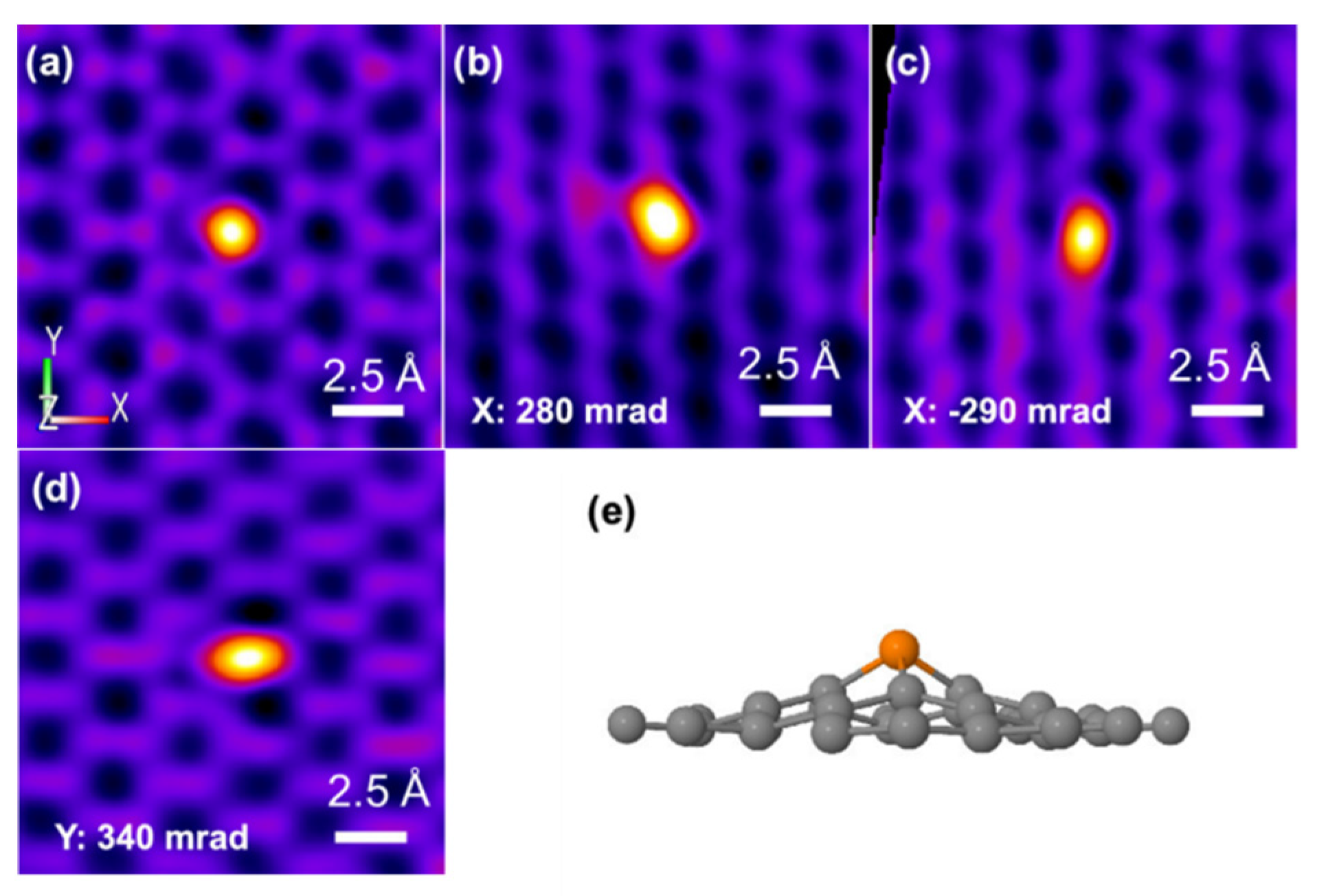
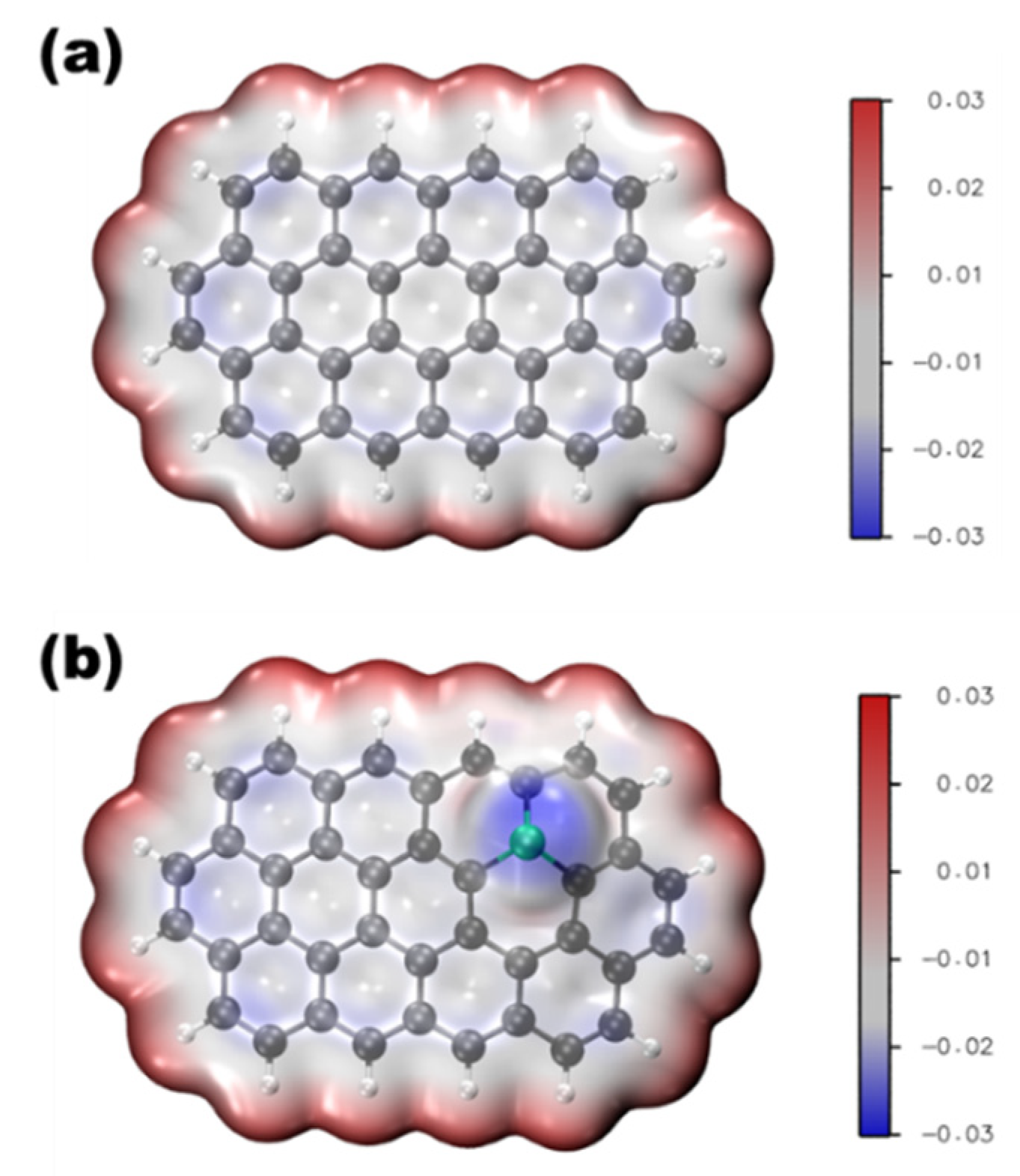
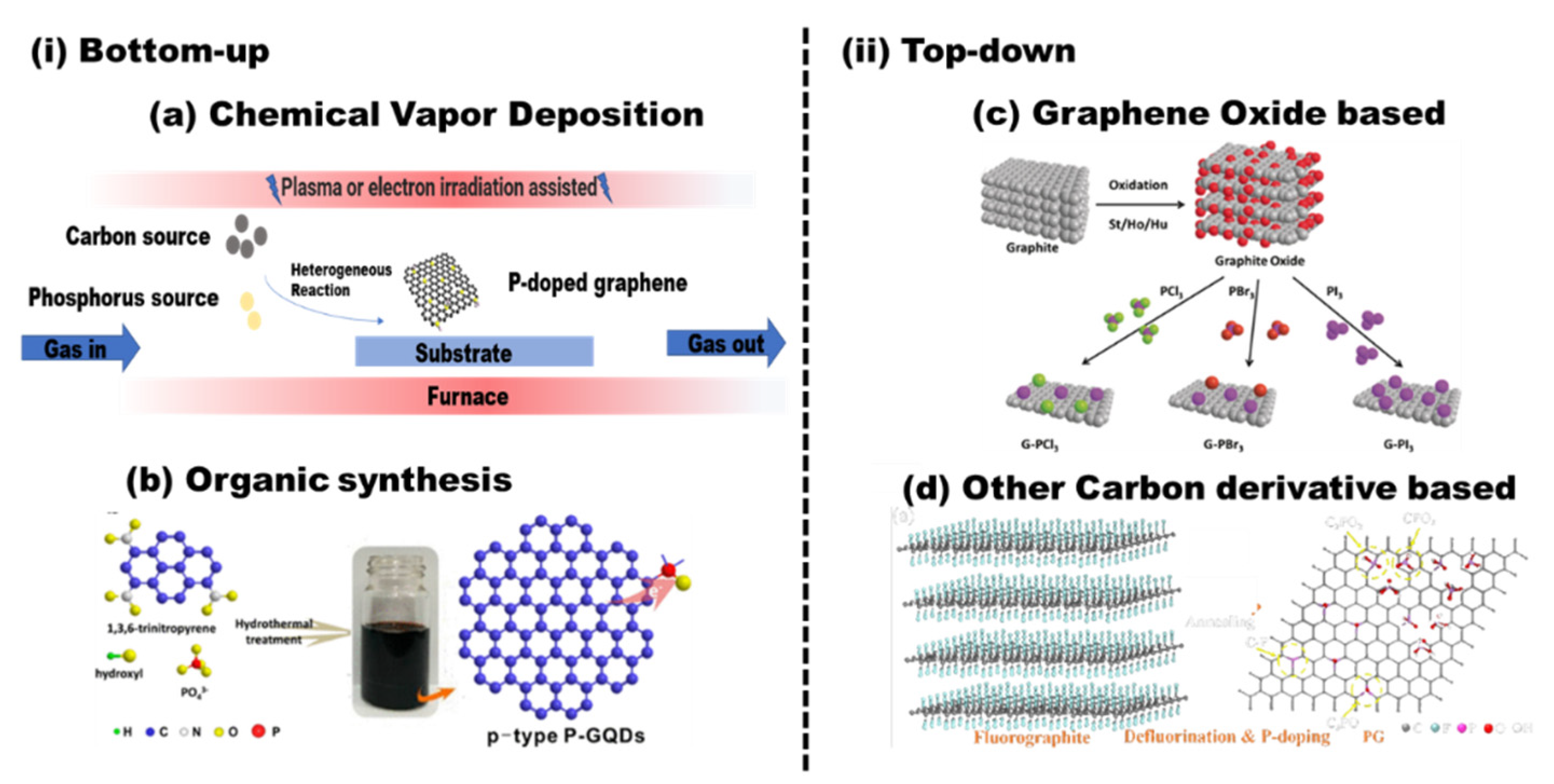
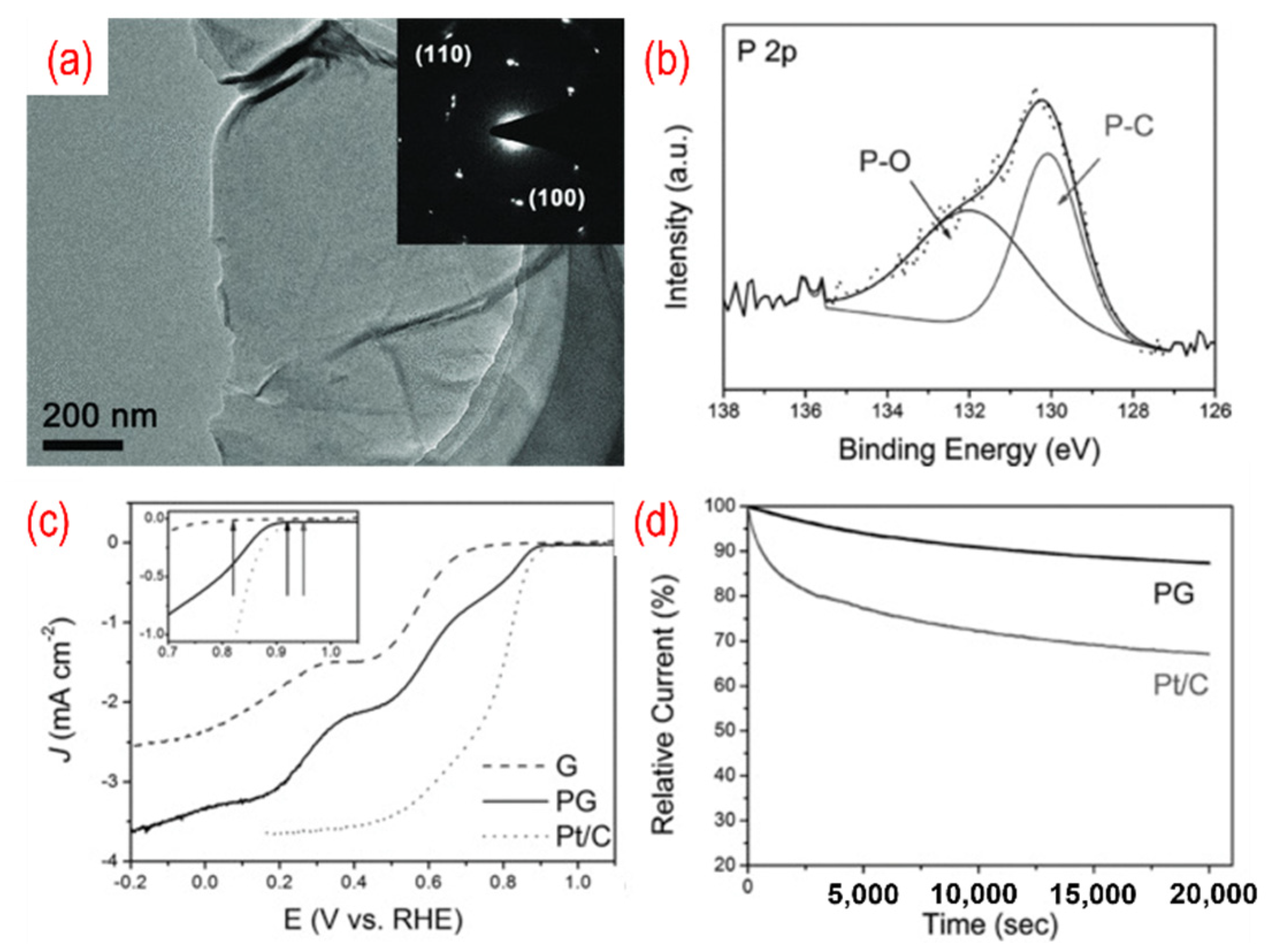
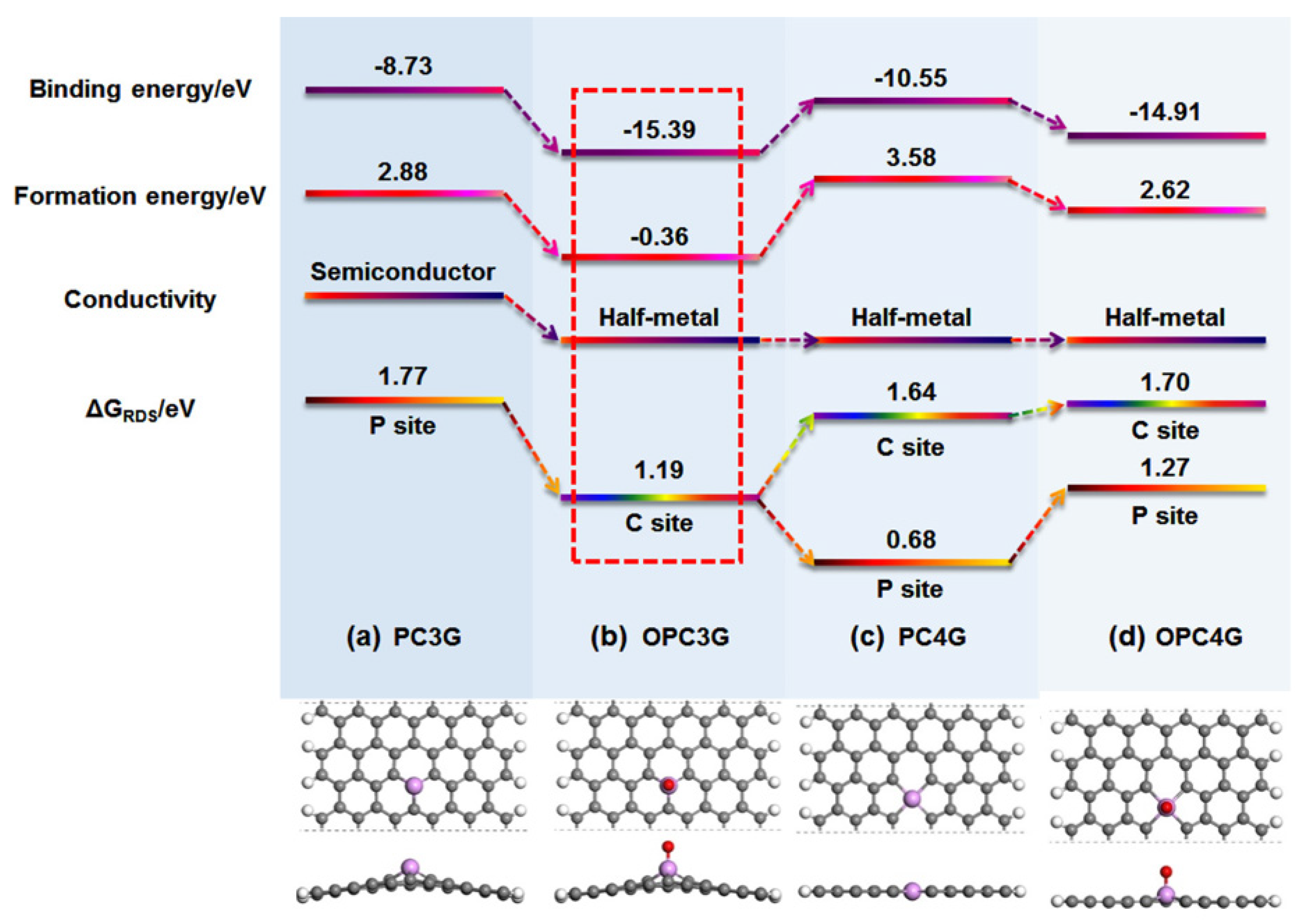
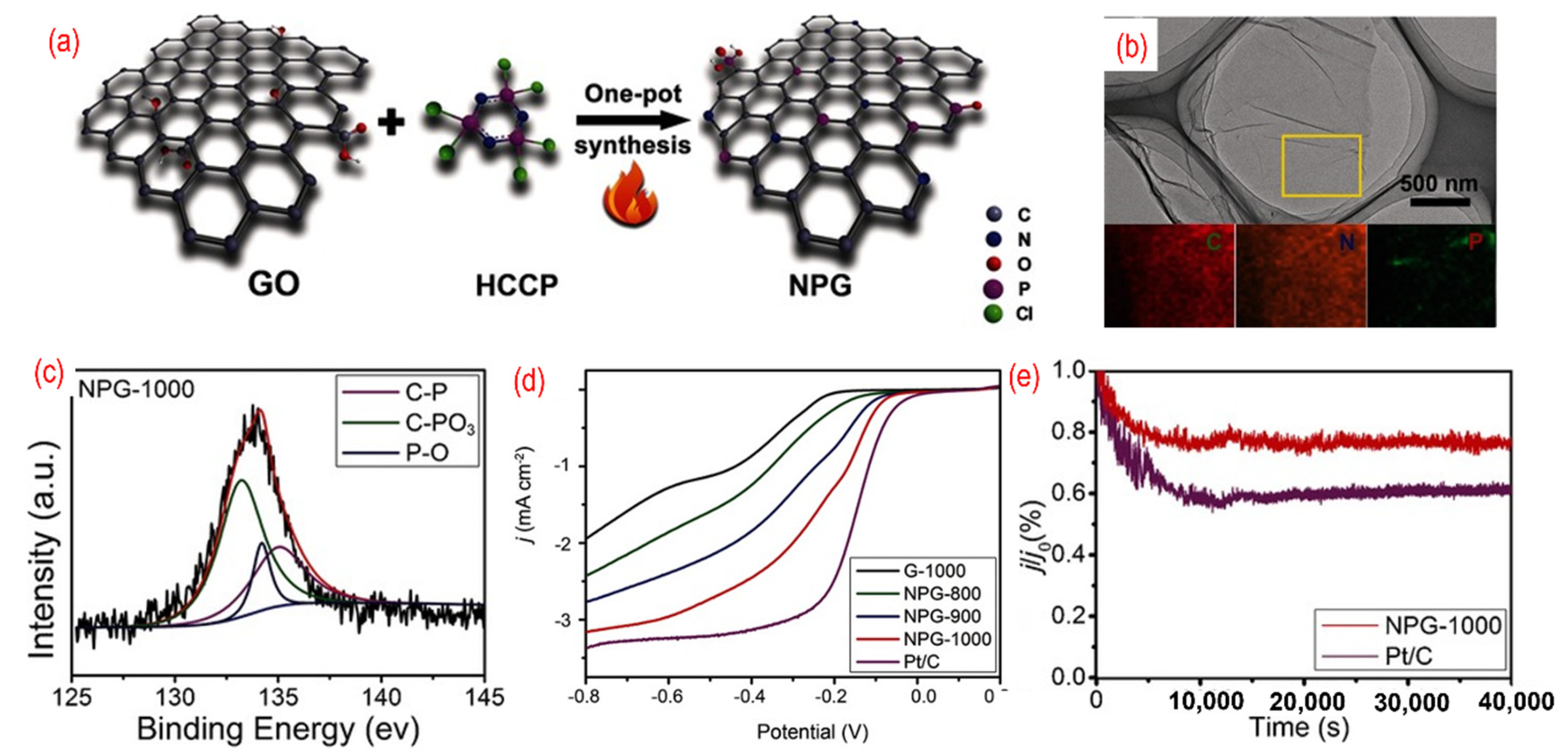
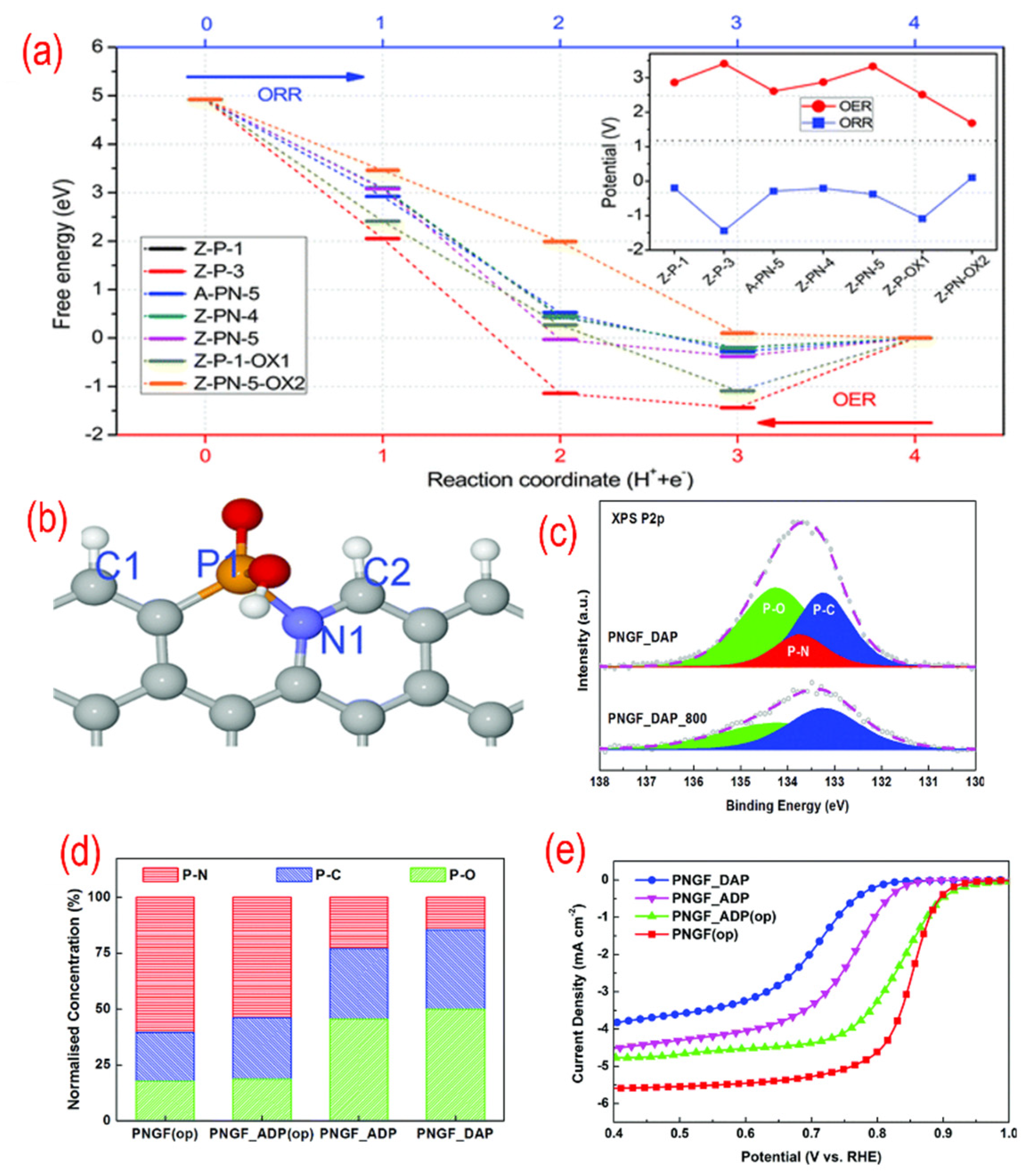
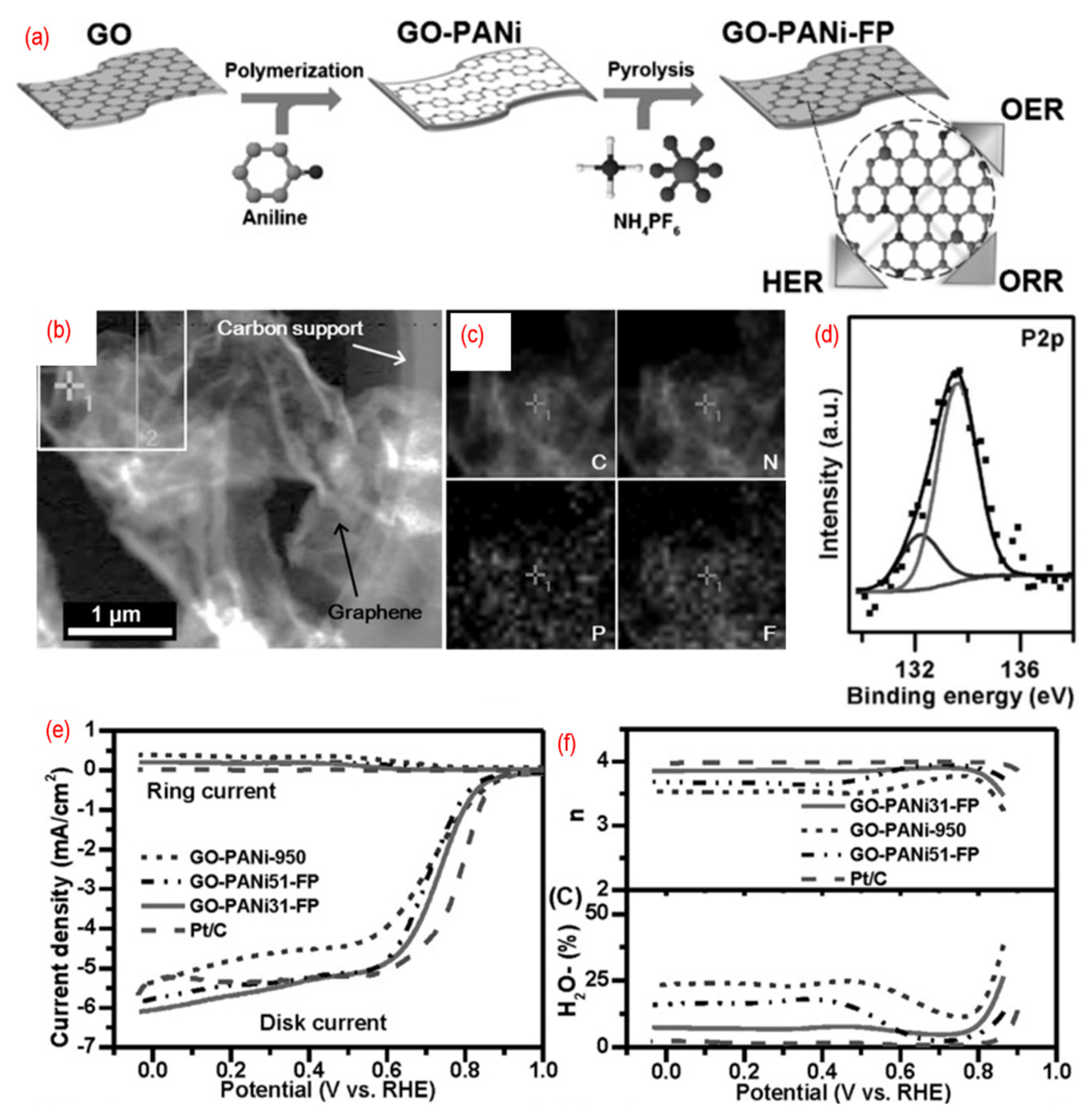

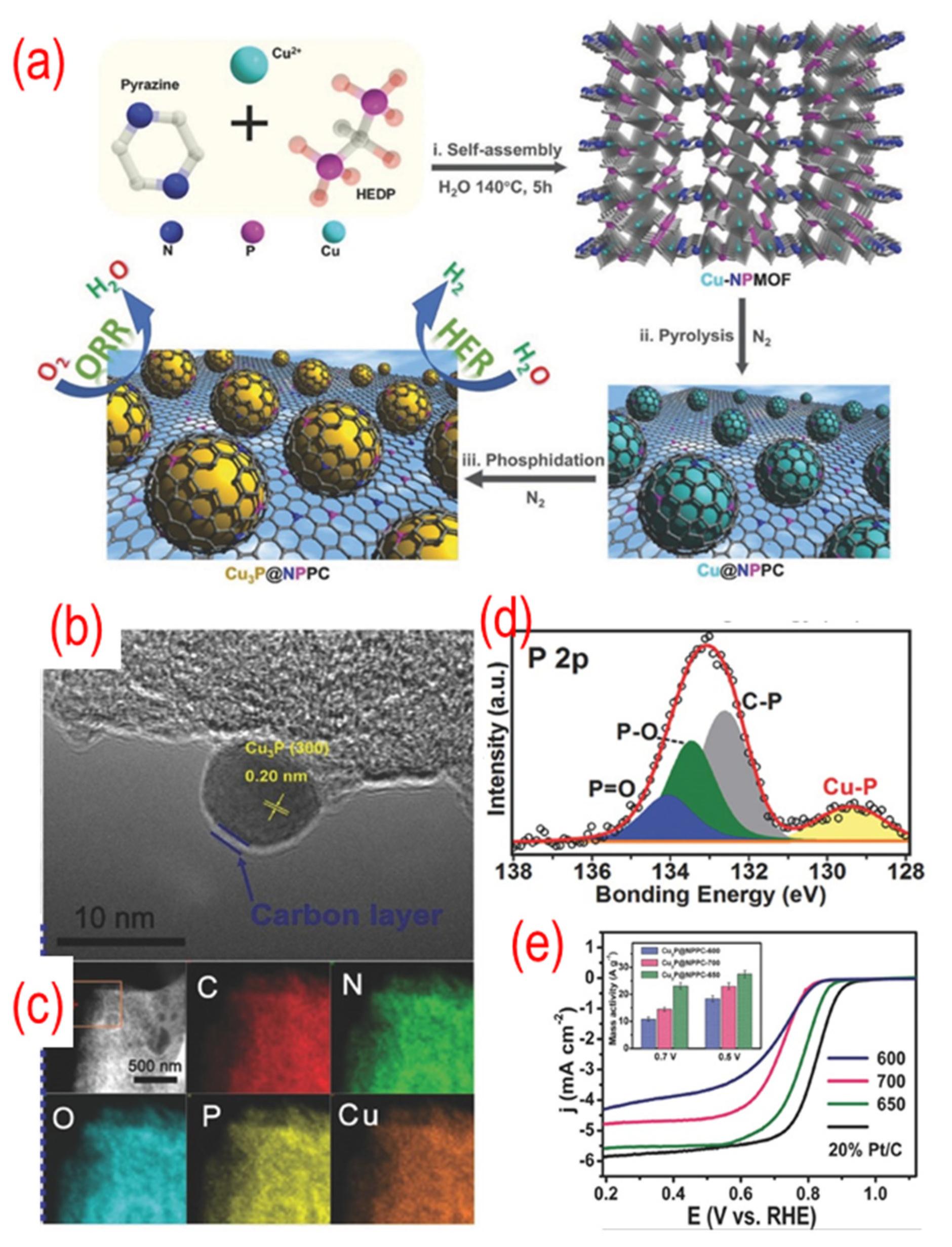
Publisher’s Note: MDPI stays neutral with regard to jurisdictional claims in published maps and institutional affiliations. |
© 2022 by the authors. Licensee MDPI, Basel, Switzerland. This article is an open access article distributed under the terms and conditions of the Creative Commons Attribution (CC BY) license (https://creativecommons.org/licenses/by/4.0/).
Share and Cite
Zhan, X.; Tong, X.; Gu, M.; Tian, J.; Gao, Z.; Ma, L.; Xie, Y.; Chen, Z.; Ranganathan, H.; Zhang, G.; et al. Phosphorus-Doped Graphene Electrocatalysts for Oxygen Reduction Reaction. Nanomaterials 2022, 12, 1141. https://doi.org/10.3390/nano12071141
Zhan X, Tong X, Gu M, Tian J, Gao Z, Ma L, Xie Y, Chen Z, Ranganathan H, Zhang G, et al. Phosphorus-Doped Graphene Electrocatalysts for Oxygen Reduction Reaction. Nanomaterials. 2022; 12(7):1141. https://doi.org/10.3390/nano12071141
Chicago/Turabian StyleZhan, Xinxing, Xin Tong, Manqi Gu, Juan Tian, Zijian Gao, Liying Ma, Yadian Xie, Zhangsen Chen, Hariprasad Ranganathan, Gaixia Zhang, and et al. 2022. "Phosphorus-Doped Graphene Electrocatalysts for Oxygen Reduction Reaction" Nanomaterials 12, no. 7: 1141. https://doi.org/10.3390/nano12071141
APA StyleZhan, X., Tong, X., Gu, M., Tian, J., Gao, Z., Ma, L., Xie, Y., Chen, Z., Ranganathan, H., Zhang, G., & Sun, S. (2022). Phosphorus-Doped Graphene Electrocatalysts for Oxygen Reduction Reaction. Nanomaterials, 12(7), 1141. https://doi.org/10.3390/nano12071141







